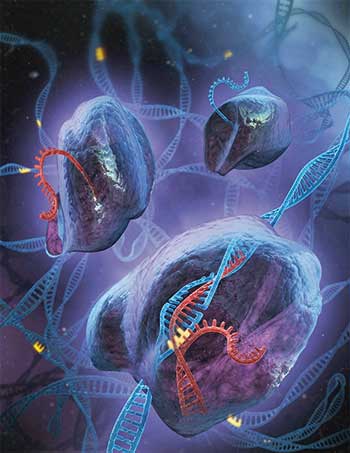A Novel Cas9 Recognizes More DNA Targets

Researchers from the Massachussets General Hospital (MGH) have engineered the Cas9 nuclease from Staphylococcus aureus (SaCas9) to recognize more targets. The prokaryote RNA-guided immune system, used as a genome editing tool, can target now a broader range of nucleotide sequences. The study has been published in the journal Nature Biotechnology.
The Clustered Regularly Interspaced Short Palindromic Repeats (CRISPR) and associated Cas genes are a bacterial defense system against extraneous genetic material. Some bacteria and archaea, upon entry of foreign DNA, incorporate it at the CRISPR loci. When this loci is transcribed, RNA is processed into crRNA, which binds Cas endonucleases and targets them to cleave alien, complementary DNA sequences. Some years ago, researchers became aware of its potential as a genome editing tool: by engineering the crRNA sequence to match that of any desired locus in the genome, Cas9 would be targeted to nick that region. Since then, multiple variants and improvements of CRISPR/Cas9 have been designed. The last innovation comes from the MGH, where scientists have engineered SaCas9 to recognize more targets. Another important advance is the use of Staphylococcus aureus instead of the classical Streptococcus pyogenes (Sp). SaCas9 sequence is 20% smaller than SpCas9, which is important when trying to deliver it via virus.
To target the Cas9 nuclease to the desired locus, the crRNA sequence must be engineered to match the DNA sequence to be nicked. But in addition, Cas9 needs to recognize a protospacer adjacent motif (PAM) right downstream the RNA-DNA duplex. This PAM is usually of the form NGG, where N is any nucleotide and G is a guanine. In a previous study published in Nature, the MGH researchers engineered SpCas9 to recognize a higher number of PAM sequences, obtaining a Cas9 that doubled its potential targets.
Molecular evolution to change the PAM sequence
In their last experiments, the team switched to SaCas9, which recognizes the PAM sequence NNGRRT, where N is any nucleotide, G is a guanine, R is an adenine or a guanine and T is a thymine. The researchers used the same molecular evolution technique they applied in their previous study and obtained the KKH SaCas9 variant, that targets the PAM sequence NNNRRT: now, the third position can be occupied by any nucleotide. This PAM increases the number of target by two- to four-fold. The number of off-target events was tested and found to be comparable between the wild type and the artificially evolved Cas9.
This technique will be very useful to obtain new versions of Cas9. Structural information of the molecule is not necessary, so the method could be applied to any Cas9 ortholog. But above all, it will be very effective in studies where the target site has to be very precise, when the DNA break needs to be very close to a given site.
Source: MGH
